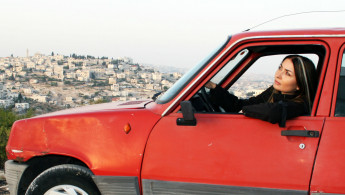The real Christmas story: Bethlehem today
Christian pilgrims from all over the world are herded into Bethlehem on Israeli buses. They shuffle through the Church of the Nativity for an hour or so, buy souvenirs from Manger Square, and are bussed out again, mostly unconscious that they have entered Palestinian territory.
They are unconscious too of the fact that the Palestinians of Bethlehem, who include some of the most ancient Christians in the world, and who have lived side by side with Muslims and Jews for centuries, are effectively imprisoned, while being impoverished and forced into exile.
In fact, the ancient city of Bethlehem itself is being destroyed, its homes bulldozed, the farms and olive groves
| We need to stop the erosion of Palestine as a diverse society. - Leila Sansour |
in its countryside annihilated, its very existence threatened by partition and annexation in the form of Israel’s encroaching settlements and great concrete separation wall.
All this is conatined in Open Bethlehem, Leila Sansour’s new feature-length documentary. Using maps and clear explanations of the geopolitical situation, fascinating footage of everyday life in Bethlehem, and a narrative that is both personal and lyrical, the film is an insider’s view of the city and its plight.
The film has been years in the making, and it shows. Its coverage of so many political and social issues and its wealth of visual imagery could only have been garnered over time. Sansour returned to her hometown of Bethlehem for Christmas 2004 with the intention of living there for a year and making a film, but she ended up staying several years and starting a high-profile international campaign to save Bethlehem.
“It was a mess for a while”, Sansour told al-Araby al-Jadeed in an interview, because she went back and forth between filming and developing the campaign. “It was four or five years later that I realized I had a peculiar, personal story that would allow me to showcase all the material”.
A personal story
Sansour was born to a Palestinian father and Russian mother in Moscow. She grew up hearing her father’s stories about Bethlehem and believing the place to be like a “fairy tale”.
They moved back when she was six. The young Leila was less keen on the reality of her new home. By age 18, she was determined to get out and find her own path away from the shadow of her father, a widely-respected university professor who would appeal on behalf of his students when they were arrested during protests, at a time when Bethlehem University was a hotbed of activism during the first Intifada, the uprising of the late 1980s.
Sansour travelled the world, studied philosophy, became a film-maker and married an Englishman, returning only for holidays. Her extended return in 2004 after her father’s death represents not only a physical return to Bethlehem, it also led her to take up her father’s sense of responsibility towards Palestine.
In an interview Tuesday, Sansour said that when she shows visitors around Bethlehem and points out the stark realities, “they cannot believe their own eyes”.
Her film shows the real story of Bethlehem, taking us on a journey through the historical and contemporary city. We see Bethlehem in black and white footage from British mandate-period tourist information films; in media segments of protests during the first and second Intifadas; in affectionate images of the city, its people and surrounding landscape; in the shaky home movie camera scenes of Sansour’s childhood.
Visiting neighbours and relatives, she films the way Israel’s looming, grey separation wall cuts them off from their gardens and olive groves, blocks their livelihoods as well as their views, isolates them from their communities and shuts down one of the oldest major thoroughfares in the country, severing Bethlehem from its “twin” city, Jerusalem.
“If anyone goes close to the wall they start shooting”, says architect Bassem Khoury, who points to the bullet holes marking his living room walls. As for compensation, he shrugs: “Who’s going to compensate you? Nobody”.
Another of the wall’s many victims, shopkeeper Khalil Mussallem, found himself on its wrong side. The soldiers and bulldozers turned up one day and took his land. “It was done in one month”, he tells Sansour. “Forty years of work… How does one forget the work of a lifetime?”
His shop used to stand at the entrance to Bethlehem. “Workers, tourists, everyone came here and I was king of Bethlehem,” he laments. “Now I’m a beggar”. He started a court case, but the court cited “security reasons”.
“They’ve swallowed the whole world with that excuse”, Mussallem says. He is one of the people to whom the film pays tribute; he died shortly after the diggers took away his world.
The campaign
The film equally traces the development of Sansour’s international campaign to save the city, also called Open Bethlehem.
As with any Palestinian non-governmental organisation, in order to secure funding, Sansour explains in the film, the campaign had to be apolitical.
It began as a tourist project - a useful approach when more than 65 percent of Bethlehem’s economy relies on tourism.
But the city lacked visitors because Israel controls access. Securing $160,000 from Swiss development agencies, Sansour and her team proposed new attractions to get tourists to stay longer, such as an evening at a Syriac church, where mass is carried out in Aramaic, the language of Christ.
Bethlehem’s mayor, its governor and religious and social leaders came on board. Ingeniously, a symbol was created for the campaign - the Bethlehem passport – “a symbolic citizenship open to all who wish to help save the city and the message that stands behind it: joy and good will to all”.
The campaign quickly gained momentum and received enthusiastic support from celebrities and leaders, including former US president Jimmy Carter and Rowan Williams, the Archbishop of Canterbury.
But cracks appeared. Donors retreated when the agenda appeared political and the resources of friends were depleted. Just when the White House seemed within reach, the project turned out to be too small to meet the challenges of high-level political lobbying.
With the current release of her film in the UK, Sansour is also relaunching the campaign – “with a little more realism” and more strategic lobbying, she said in the interview.
Transcending sectarianism
Some may criticize Sansour’s emphasis on Palestinian Christians, but this would be to deny their importance. They are an integral and ancient part of the region and have often been good intermediaries between Europe and the Middle East.
Nevertheless, I had to ask whether she felt westerners were more willing to help Christians over Muslims. “There’s certainly a bit of that out there”, she replied, but said that Palestinians themselves are united. “Compartmentalizing people is a sure way to create societies that can’t live with difference or create democracy”, she said. “We need to stop the erosion of Palestine as a diverse society”.
Open Bethlehem is essential viewing for Christians all over the world, who cannot claim to believe in the perennial values of peace, love and joy without being concerned about the onslaught on Bethlehem.
But like the city itself, the film and campaign are not only for Christians. They are equally for Muslims, Jews, believers and non-believers of all shades and descriptions, who share important moral values. The city is a symbol of and gateway to an ancient and multicultural Palestine that has been attacked and eroded since 1948. Bethlehem and Palestine remain the centre of the world, but today it is for all the wrong reasons, and we are all responsible.
Find screenings and learn more about the Open Bethlehem campaign: http://www.openbethlehem.org



